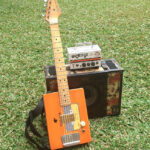Understanding minor chords is fundamental to playing guitar, and the A minor chord is a cornerstone in countless songs across genres. Often, learning chords is made easier when you grasp their relationship to major keys. This approach not only simplifies memorization but also enhances your understanding of music theory on the fretboard. Let’s explore how to find the A minor chord and understand the patterns that can unlock all minor chords for you.
Minor Chords in the Landscape of Major Keys
Minor chords aren’t just random collections of notes; they exist in a structured relationship with major keys. A key concept to understand is the idea of the “relative minor.” Every major key has a relative minor key that shares the same key signature (same sharps or flats). The relative minor is found a minor third below the major key.
For example, let’s consider the key of C major. If you count down a minor third (three half steps) from C, you arrive at A. This means A minor is the relative minor of C major. Both C major and A minor keys share the same key signature – no sharps or flats.
This relationship extends to chords within a key. In any major key, certain chords will naturally be minor. If we think about the key of G major (which has one sharp, F#), and number the chords based on the scale degrees:
- G Major (I) – The root, a major chord.
- A Minor (ii) – The second chord in the key is minor.
- B Minor (iii) – The third chord in the key is also minor.
- C Major (IV) – The fourth chord is major.
- D Major (V) – The fifth chord is major (dominant).
- E Minor (vi) – The sixth chord is minor (the relative minor!).
- F# Diminished (vii°) – The seventh chord is diminished (less common in basic progressions).
Notice the pattern: in a major key, the ii, iii, and vi chords are minor. This is a consistent pattern across all major keys and is crucial for understanding chord relationships.
Finding the A Minor Chord on Your Guitar
Now, let’s specifically focus on the A minor chord. The most common and first position many guitarists learn is the open A minor chord.
To play the open A minor chord:
- Place your index finger on the 2nd string (B string), 1st fret.
- Place your middle finger on the 4th string (D string), 2nd fret.
- Place your ring finger on the 3rd string (G string), 2nd fret.
- Strum all strings from the 5th string (A string) downwards. The 6th string (low E string) is typically not played in this voicing, but strumming it lightly won’t drastically alter the sound for beginners.
[Placeholder Image URL – Replace with actual image URL of open A minor chord diagram]
This open A minor chord is a versatile and essential chord. You’ll find it in countless songs in various keys.
Exploring Patterns and Positions for A Minor
Beyond the open position, understanding the pattern of minor chords allows you to find A minor in other positions on the fretboard. Thinking back to our key of G major example:
- If G major is often found around the 3rd fret area (depending on the specific voicing), then E minor (the vi chord) will also be in a related area, and so will A minor (the ii chord), and B minor (the iii chord).
While the original forum post mentioned pedal steel guitar techniques, the core idea translates to standard guitar. The concept is about relative positioning. If you know where a G major chord form is, you can often find related minor chords nearby by applying patterns.
For instance, barre chords are excellent for exploring these patterns. An A minor barre chord can be played in several positions, commonly based on the E minor barre chord shape.
- E minor barre shape: If you know the E minor barre chord shape (often starting on the 7th fret for an B minor chord), you can move that shape down the neck.
- To find A minor using this shape, you would position the root of the barre chord shape on the A note on the 5th string. This would be at the 5th fret.
[Placeholder Image URL – Replace with actual image URL of A minor barre chord diagram based on E minor shape]
Experiment with moving barre chord shapes and open chord shapes around the fretboard. As you do, start to recognize the intervallic relationships and patterns. Understanding that A minor is the ii chord in G major, or the relative minor of C major, gives you a theoretical framework to guide your exploration.
Using Patterns to Learn All Minor Chords
The principle discussed here extends beyond just the A minor chord. By understanding the relationship of minor chords to major keys and recognizing chord shapes and patterns, you can systematically learn all minor chords across the fretboard.
Start with a major key, identify the ii, iii, and vi chords, and then find those minor chords on your guitar using different positions and voicings. This pattern-based approach is far more effective than memorizing each chord in isolation.
Conclusion
The A minor chord is a vital chord for any guitarist. By understanding its place within music theory, particularly its relationship to major keys and the patterns it forms with other chords, you can unlock a deeper understanding of the guitar and music itself. Start with the open A minor, explore barre chord shapes, and begin to see the patterns emerge. This approach will not only help you master A minor but also pave the way for learning all minor chords and expanding your guitar playing.

